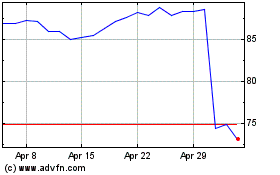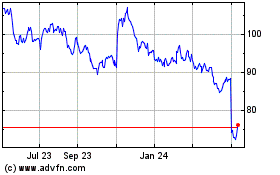Can Starbucks Perk Back Up? -- WSJ
October 27 2018 - 3:02AM
Dow Jones News
Surrounded by rivals and new coffee trends, the Seattle chain
looks to stir faster growth
By Julie Jargon
This article is being republished as part of our daily
reproduction of WSJ.com articles that also appeared in the U.S.
print edition of The Wall Street Journal (October 27, 2018).
Starbucks Corp. has been in a funk over the past 2 1/2 years,
posting quarterly same-store sales growth well below its historic
rate of 5% or greater in the U.S., where the brand once seemed
unstoppable.
The problem? The coffee culture Starbucks helped create in
America spawned all kinds of competitors on both the high and low
end, leaving Starbucks in the middle -- and still charging premium
prices.
A confluence of changes in consumer behavior has contributed to
the coffee giant's slowed growth. People are increasingly consuming
on the go, a trend Starbucks was way ahead on with its 2009
development of a mobile app. But now almost every coffee chain has
an app.
Starbucks's app became so popular that it created another
problem: people milling around the area where drinks are handed
off. This scared off customers who saw the crowds from outside.
Starbucks sought to fix that by adding staff, using the shops'
extra espresso machines and upgrading its app to notify customers
when orders are ready.
While Starbucks was busy fixing its app's popularity problem, it
was also dealing with another one: a shift away from hot coffee.
Starbucks was quick to respond in its shops with cold drinks, which
now represent more than 50% of U.S. cafe sales. But the growing
preference for cold coffee spurred a new category of canned and
bottled cold brew that's widely available at retailers -- and
another option for on-the-go consumption that's detracting from
coffee shop visits.
The availability of so much coffee has taken a toll on
Starbucks, particularly in the afternoon, when consumers aren't as
loyal to their coffee brand as they are in the morning. Afternoon
visitors tend to be those who visit Starbucks five or fewer times
each month.
The company says it is trying to entice customers to return more
often with new food, drink deals and the option to use its mobile
app, which previously had been available only to members of the
chain's loyalty program.
There's also been a gradual shift to eating more at home.
Starbucks says Americans get their coffee in retail stores only 20%
of the time. The company is hoping to sell more of its packaged
coffee for at-home consumption through a new deal with Nestle
SA.
The company's recent woes have attracted activist investor
William Ackman, who recently disclosed a 1.1% stake. He said he
thinks Starbucks's stock price could more than double in price over
the next three years.
For now, Mr. Ackman doesn't appear to be taking an activist
stance and says he thinks the changes the company is making, such
as slowing store growth and expanding in China, are the right
ones.
The company reports earnings for its fiscal fourth quarter on
Nov. 1. It will be the first full quarter without the involvement
of Howard Schultz, who stepped down as company chairman at the end
of June. Some analysts expect Starbucks, which has reduced its
long-term growth targets already, to do so again when it reports
earnings this coming week -- or at an investor meeting in December
-- as it adjusts to a new reality of being a mature brand in the
hypercompetitive market it helped create.
-- Graphics by Kurt Wilberding
Write to Julie Jargon at julie.jargon@wsj.com
(END) Dow Jones Newswires
October 27, 2018 02:47 ET (06:47 GMT)
Copyright (c) 2018 Dow Jones & Company, Inc.
Starbucks (NASDAQ:SBUX)
Historical Stock Chart
From Jun 2024 to Jul 2024

Starbucks (NASDAQ:SBUX)
Historical Stock Chart
From Jul 2023 to Jul 2024
